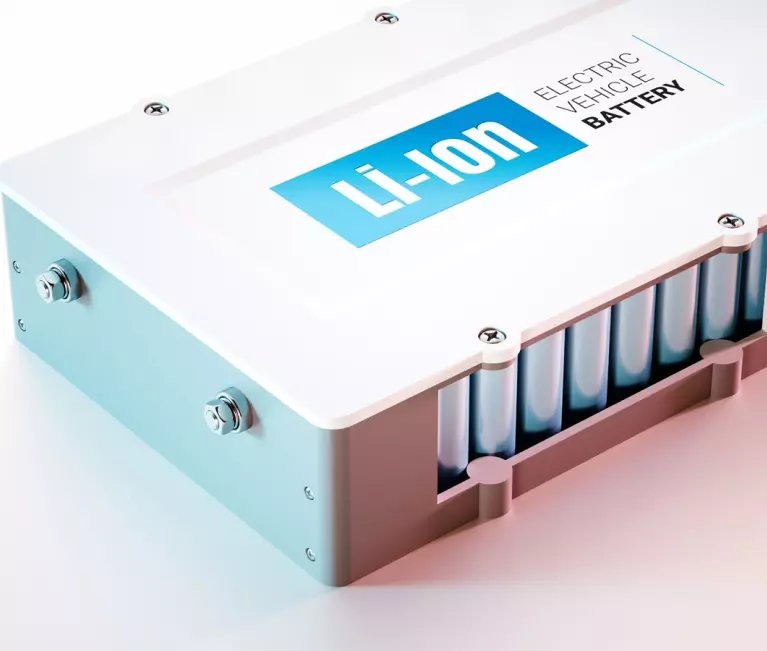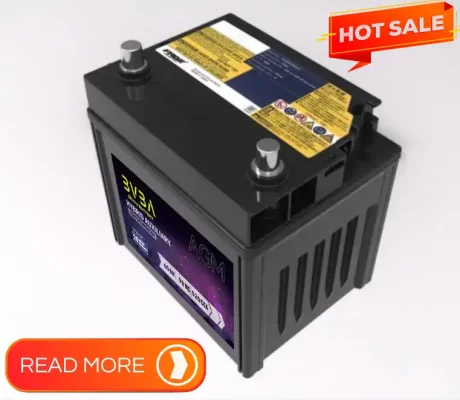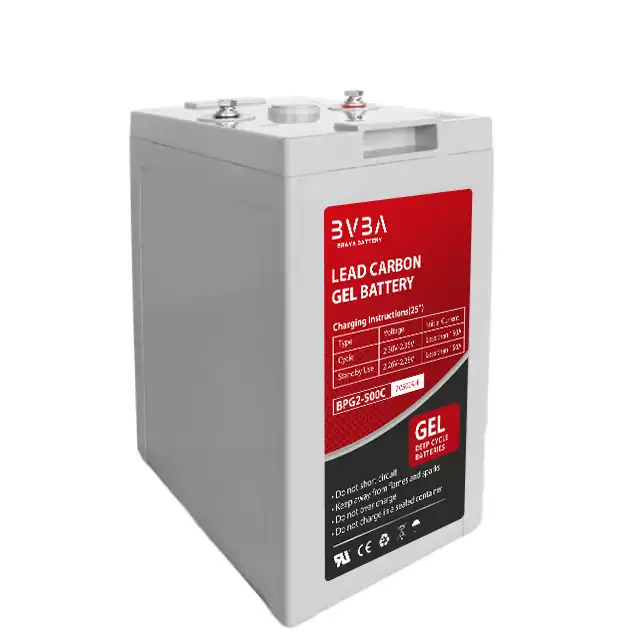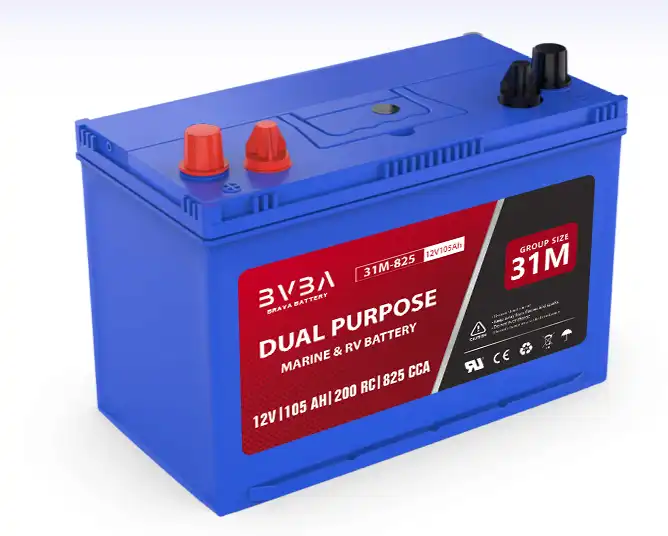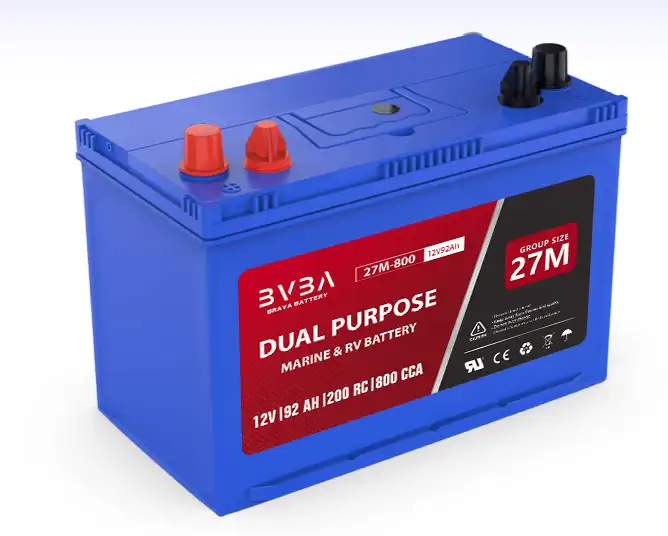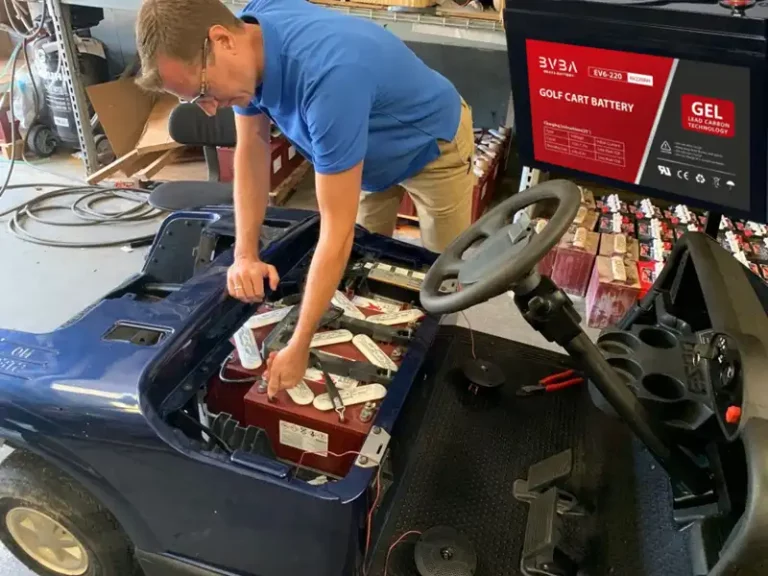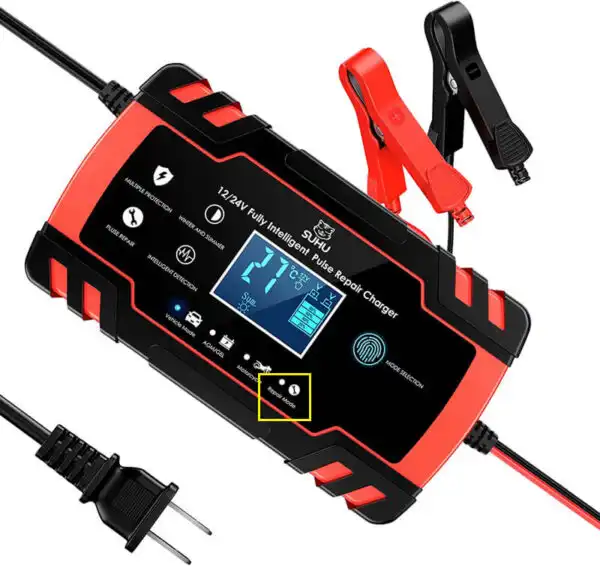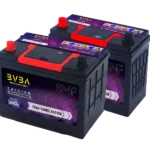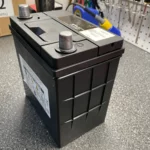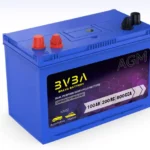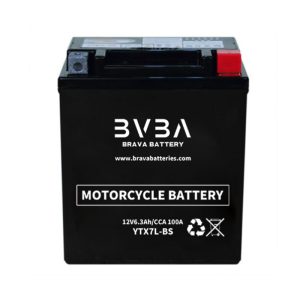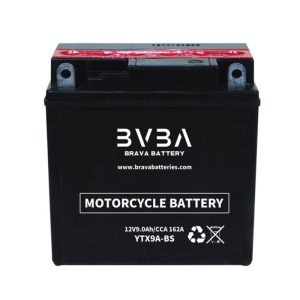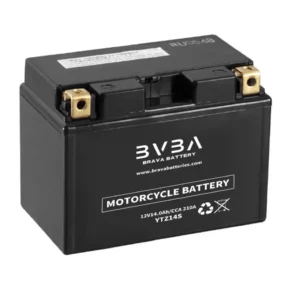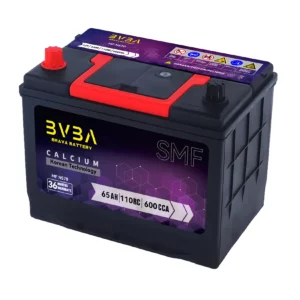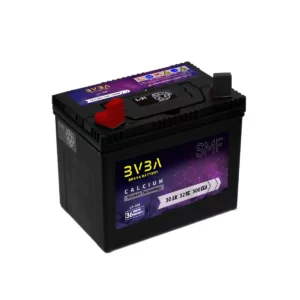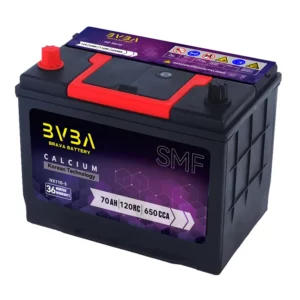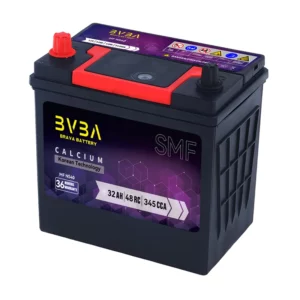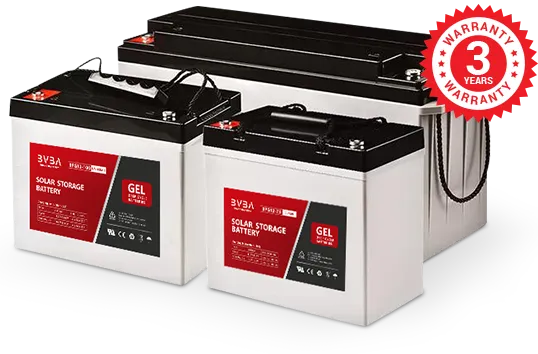Electric vehicle battery
or the starting, lighting and ignition system battery of an automobile
An electric vehicle battery (EVB, also known as a traction battery) is a rechargeable battery used to power the electric motors of a battery electric vehicle (BEV) or hybrid electric vehicle (HEV). Typically lithium-ion batteries, they are specifically designed for high electric charge (or energy) capacity.
Electric vehicle batteries differ from starting, lighting, and ignition (SLI) batteries as they are designed to give power over sustained periods of time and are deep-cycle batteries. Batteries for electric vehicles are characterized by their relatively high power-to-weight ratio, specific energy and energy density; smaller, lighter batteries are desirable because they reduce the weight of the vehicle and therefore improve its performance. Compared to liquid fuels, most current battery technologies have much lower specific energy, and this often impacts the maximum all-electric range of the vehicles.
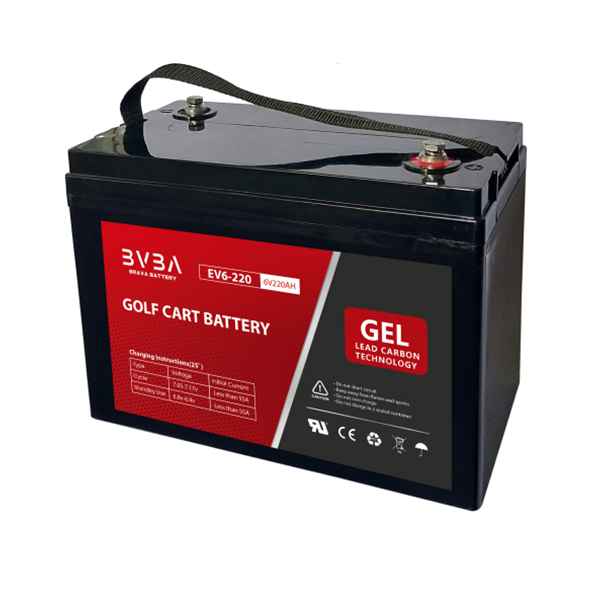
How do electric car batteries work?
Where internal combustion engined cars get energy from burning petrol or diesel, an electric vehicle gets its power directly from a big pack of batteries.
These are much like a scaled up version of the lithium-ion (Li-ion) battery in your mobile phone – EVs don’t use a single battery like a phone, they use instead a pack which is comprised of thousands of individual Li-ion cells working together. When the car’s charging up, electricity is used to make chemical changes inside its batteries. When it’s on the road, these changes are reversed to produce electricity.
Electric car battery technology
EV batteries undergo cycles of ‘discharge’ that occur when driving and ‘charge’ when the car’s plugged in. Repeating this process over time affects the amount of charge the battery can hold. This decreases the range and time needed between each journey to charge. Most manufacturers have a five to eight-year warranty on their battery. However, the current prediction is that an electric car battery will last from 10 – 20 years before they need to be replaced.
How a battery and the car’s electric motor work together is surprisingly simple – the battery connects to one or more electric motors, which drive the wheels. When you press the accelerator the car instantly feeds power to the motor, which gradually consumes the energy stored in the batteries.
Electric motors also work as generators, so when you take your foot off the throttle the car begins to slow down by converting its forward motion back into electricity – this happens more strongly if you hit the brakes. This regenerative braking recovers energy that would otherwise be lost, storing it in the battery again and so improving the car’s range.
Electric car battery lithium-ion
A Lithium-ion (Li-ion) battery is a type of rechargeable battery used in electric vehicles and a number of portable electronics. They have a higher energy density than typical lead-acid or nickel-cadmium rechargeable batteries. This means that battery manufacturers can save space, reducing the overall size of the battery pack.
Lithium is also the lightest of all metals. However, lithium-ion (Li-ion) batteries contain no lithium metal, they contain ions. For those wondering what an ion is, an ion is a an atom or molecule with an electric charge caused by the loss or gain of one or more electrons.
Lithium-ion batteries are also safer than many alternatives and battery manufacturers have to ensure that safety measures are in place to protect consumers in the unlikely event of a battery failure. For instance, manufacturers equip electric vehicles with charging safeguards to protect the batteries during repeated rapid charging sessions in a short period of time.
Electric car battery life
Once an EV battery loses its capacity to power a vehicle, it can be used to power a home or building by contributing to a battery storage system. A battery energy storage system stores energy from batteries that can be used at a later time.
If you power your home with renewable energy such as wind or solar, you can also pair it with an EV battery. You can store it up to use throughout the night when wind and sunlight are reduced. Or even during the day alongside solar or wind energy. This method of generating energy can help you save on bills and reduce the amount of energy you use from the grid.
The battery on an electric car is a proven technology that will last for many years. In fact, EV manufacturers guarantee it. Nissan warrants that its electric car batteries will last eight years or 100,000 miles, for example and Tesla offers a similar guarantee.
This might seem remarkable when the battery in your mobile phone begins to wear out after only a couple of years, but during that time it might be fully charged and discharged hundreds of times. Each of these so-called charge cycles counts against the life of the battery: after perhaps 500 full cycles, a lithium-ion phone battery begins to lose a significant part of the capacity it had when new.
While that might be OK in a phone, it’s not good enough for a car designed to last many thousands of miles, so EV manufacturers go to great lengths to make electric car batteries last longer. In an EV, batteries are ‘buffered’, meaning that drivers can’t use the full amount of power they store, reducing the number of cycles the battery goes through. Together with other techniques such as clever cooling systems, this means that electric car batteries should give many years of trouble-free life.
In fact, in order to preserve the life of an electric vehicle battery, manufacturers ensure that there is additional spare capacity to compensate for degradation over time. So as an electric vehicle ages and the battery cycles, the additional spare capacity is used up. This allows the range of the vehicle to stay the same throughout the life of the battery. Once the battery capacity falls below 80%, drivers may start to notice a fall in the range and performance of the battery.
Electric car battery replacement cost
When it comes to replacing an electric vehicle battery, you need not be too concerned as many manufacturers provide a warranty of up to 8 years or 100,000 miles. Meaning that even if you did need to replace it in an unfortunate event that something did go wrong, then it could well be covered under this warranty. Remember to always check the type of warranty offered by your chosen electric car manufacturer.
Also, the cost of batteries fell about 80% between 2010 and 2016 according to McKinsey, from $1000 to $227/kWh. Therefore, a new 40kWh battery in 2016 would have cost just shy of £10,000. Some predictions estimate that prices are set to fall below $100/kWh by 2030, around the same time as the government are aiming for 50% of all new vehicles sold in the UK will be electric.
Electric car battery recycling
Many manufacturers are researching how EV batteries can be repurposed once they’ve hit retirement age. One idea that’s proving to work well is repurposing EV batteries to power homes and buildings. However, there are no definitive answers as to what will happen to EV batteries once they’re no longer recyclable.
The time that batteries spend in an EV is often just the beginning of their useful life. Once removed from a car, most batteries will still be fit for other demanding jobs like energy storage in the electricity network, or in the home – a growing area of demand.
When batteries do reach the end of their working life, they’ll be recycled, which typically involves separating out valuable materials such as cobalt and lithium salts, stainless steel, copper, aluminium and plastic. At the moment, only about half of the materials in an EV battery pack are recycled, but with EVs expected to undergo an explosion in popularity over the next decade or so, car manufacturers are looking to improve this.
VW recently announced a pilot plant for battery recycling which will work towards a target of recycling 97% of battery components. In this process, batteries will be shredded, dried, then sieved to recover valuable materials that can be used to make new batteries.
Electric car battery disposal
So what happens when electric car batteries die? Batteries of all forms can prove difficult to dispose of without harming the environment. The same goes for EV batteries. However, EV battery life cycle management works towards solving expensive and toxic disposal of the batteries.
As well as being used to support the use of renewable energy, EV batteries can be refurbished to help power more vehicles in the future. Volkswagen Group has plans to start a recycling project that will see batteries assessed on their quality to determine their future. The batteries with some power left will be given a second life as power packs for mobile vehicle charging. The others that have little to give, will be ground down to a fine powder to extract raw materials such as lithium, nickel, manganese and lithium. The materials can then be rebuilt into more EV batteries.
Electric car battery manufacturers
There are a large number of electric car battery manufacturers. Some are well known such as Tesla and Nissan, while others such as BYD or LG Chem, may not be as well-known around the world, but are nevertheless, significant players in the electric car battery manufacturing space. LG Chem, for instance, supply electric vehicle batteries for the likes of Volvo, Renault, Ford and Chevrolet. Not only that, but they have also signed an agreement with Telsa to supply all Telsa produced in China with batteries.
Another major electric vehicle manufacturer BYD is China’s largest electric vehicle manufacturer more than doubled its sales in December 2020 compared to the same time in 2019 and have been selling more battery-powered vehicles since the beginning of 2019. Not only are these battery manufacturers focusing on electric vehicles, but they are also working on battery storage of electricity for residential, commercial and industrial applications.
Electric car battery charging
How far can one charge go?
Just as conventional cars have big or small fuel tanks, lithium-ion batteries for electric cars come in different sizes. Rather than litres of fuel, their capacity is measured in kilowatt hours (kWh). A typical 40kWh battery pack from a mainstream electric car might be enough to power it for 150 miles or more, while Tesla’s biggest 100kWh battery is good for 375 miles according to the WLTP standard – which aims to give a realistic estimation of cars’ real-world range or fuel economy.
WLTP is an abreviation of the Worldwide Harmonised Light Vehicle Test Procedure, which came in to effect in 2017 and was set up to measure fuel consumption,CO2 levels and other pollutant emissions from passenger cars. It replaced the New European Driving Cycle (NEDC)
You might recognise the kilowatt hour from your electricity bill – it’s the industry standard charging unit. A 40kWh battery holds enough energy to power a typical home for four days!
How do you recharge an electric car battery?
You’ll get the fastest charge from a designated EV charging socket. These are rated in kW from about 3kW up to about 50kW – or 120kW on Tesla’s supercharger network. The higher the rating, the quicker they’ll restore your EV’s range.
The chargers most commonly fitted at a home or workplace are either 3kW ‘slow’ units, or 7kW ‘fast’ chargers capable of recharging an EV in 6-12 hours. The UK also has a growing network of public charging stations. These are typically either fast chargers rated at up to 22kW, or ‘rapid’ chargers capable of delivering up to 50kW. The fastest public charging stations can top an EV up to 80% of its range in as little as an hour – the last 20% is usually a bit slower, to prevent damage to the batteries as they get near to full charge.
Where no designated charging point is available, you can charge an electric car from a 13-amp domestic plug socket, but this can be very slow. Because charging demands lots of power over a long period there may also be a risk of overheating or fire, so if you must do this you should have an electrician inspect the socket and wiring first.
How safe are electric car batteries?
The manufacturers of batteries for electric cars go to great lengths to make sure EV batteries are safe, fitting smart management systems to prevent overheating and other problems. Batteries do get warm as they charge and discharge, but cars are designed to keep them cool – high performance EVs sometimes have liquid cooling systems to help.
Despite this, there have been some cases of electric cars catching fire, but very few of these incidents have been caused by battery failures. More typically they’ve resulted from accidents or incidents that might have caused any vehicle to catch fire – such as the 2013 case of a Tesla Model S which hit a large piece of metal at high speed. Commenting on that incident, which resulted in a limited fire, Tesla CEO Elon Musk pointed out that EV batteries contain only about a tenth of the energy of a tank full of fuel, limiting the danger they pose in an accident.
In fact, a 2017 study by the US National Highway Traffic Safety Administration found that the likelihood and severity of fires from lithium-ion batteries was comparable to, or slightly less than that from conventional vehicles. As more electric vehicles take to the roads, we can be increasingly sure they’re as safe as the conventional cars they replace.
Batteries for Electric Vehicles
Energy storage systems, usually batteries, are essential for all-electric vehicles, plug-in hybrid electric vehicles (PHEVs), and and hybrid electric vehicles (HEVs).
Types of Energy Storage Systems
The following energy storage systems are used in all-electric vehicles, PHEVs, and HEVs.
Lithium-Ion Batteries
Lithium-ion batteries are currently used in most portable consumer electronics such as cell phones and laptops because of their high energy per unit mass relative to other electrical energy storage systems. They also have a high power-to-weight ratio, high energy efficiency, good high-temperature performance, and low self-discharge. Most components of lithium-ion batteries can be recycled, but the cost of material recovery remains a challenge for the industry. The U.S. Department of Energy is also supporting the Lithium-Ion Battery Recycling Prize to develop and demonstrate profitable solutions for collecting, sorting, storing, and transporting spent and discarded lithium-ion batteries for eventual recycling and materials recovery. Most of today’s all-electric vehicles and PHEVs use lithium-ion batteries, though the exact chemistry often varies from that of consumer electronics batteries. Research and development are ongoing to reduce their relatively high cost, extend their useful life, and address safety concerns in regard to overheating.
Nickel-Metal Hydride Batteries
Nickel-metal hydride batteries, used routinely in computer and medical equipment, offer reasonable specific energy and specific power capabilities. Nickel-metal hydride batteries have a much longer life cycle than lead-acid batteries and are safe and abuse tolerant. These batteries have been widely used in HEVs. The main challenges with nickel-metal hydride batteries are their high cost, high self-discharge and heat generation at high temperatures, and the need to control hydrogen loss.
Lead-Acid Batteries
Lead-acid batteries can be designed to be high power and are inexpensive, safe, and reliable. However, low specific energy, poor cold-temperature performance, and short calendar and lifecycle impede their use. Advanced high-power lead-acid batteries are being developed, but these batteries are only used in commercially available electric-drive vehicles for ancillary loads.
Ultracapacitors
Ultracapacitors store energy in a polarized liquid between an electrode and an electrolyte. Energy storage capacity increases as the liquid’s surface area increases. Ultracapacitors can provide vehicles additional power during acceleration and hill climbing and help recover braking energy. They may also be useful as secondary energy-storage devices in electric-drive vehicles because they help electrochemical batteries level load power.
Recycling Batteries
Electric-drive vehicles are relatively new to the U.S. auto market, so only a small number of them have approached the end of their useful lives. As electric-drive vehicles become increasingly common, the battery-recycling market may expand.
Widespread battery recycling would keep hazardous materials from entering the waste stream, both at the end of a battery’s useful life and during its production. The material recovery from recycling would also reintroduce critical materials back into the supply chain and would increase the domestic sources for such materials. Work is now underway to develop battery-recycling processes that minimize the life-cycle impacts of using lithium-ion and other kinds of batteries in vehicles. But not all recycling processes are the same and require different methods of separation for material recovery:
- Smelting: Smelting processes recover basic elements or salts. These processes are operational now on a large scale and can accept multiple kinds of batteries, including lithium-ion and nickel-metal hydride. Smelting takes place at high temperatures where organic materials, including the electrolyte and carbon anodes, are burned as fuel or reductant. The valuable metals are recovered and sent to refining so that the product is suitable for any use. The other materials, including lithium, are contained in the slag, which is now used as an additive in concrete.
- Direct recovery: At the other extreme, some recycling processes directly recover battery-grade materials. Components are separated by a variety of physical and chemical processes, and all active materials and metals can be recovered. Direct recovery is a low-temperature process with minimal energy requirement.
- Intermediate processes: The third type of process is between the two extremes. Such processes may accept multiple kinds of batteries, unlike direct recovery, but recover materials further along the production chain than smelting does.
Separating the different kinds of battery materials is often a stumbling block in recovering high-value materials. Therefore, battery design that considers disassembly and recycling is important in order for electric-drive vehicles to succeed from a sustainability standpoint. Standardizing batteries, materials, and cell design would also make recycling easier and more cost-effective.
Lifecycle of lithium-based EV batteries
There are mainly four stages during the lifecycle of lithium-based EV batteries: the raw materials phase, the battery manufacturing, operation phase and the end-of-life management phase. As shown in the schematic of life cycle of EV batteries, during the first stage, the rare earth materials are extracted in different parts of the world. After they are refined by pre-processing factories, the battery manufacturing companies take over these materials and start to produce batteries and assemble them into packs. These battery packs are then sent to car manufacturing companies for EV integration. In the last stage, if no management is in place, valuable materials in the batteries could be potentially wasted. A good end-of-life management phase will try to close the loop. The used battery packs will either be reused as stationary storage or recycled depending on the battery state of health (SOH).
The battery lifecycle is rather long and requires close cooperation between companies and countries. Currently, the raw materials phase and the battery manufacturing and operation phase are well established. The end-of-life management phase is struggled to grow, especially the recycling process mainly because of economics. For example, only 6% of lithium-ion batteries were collected for recycling in 2017–2018 in Australia. However, closing the loop is extremely important. Not only because of a predicted tightened supply of nickel, cobalt and lithium in the future, also recycling EV batteries has the potential to maximize the environmental benefit. Xu et al. predicted that in the sustainable development scenario, lithium, cobalt and nickel will reach or surpass the amount of known reserves in the future if no recycling is in place.[85] Ciez and Whitacre found that by deploying battery recycling some green house gas (GHG) emission from mining could be avoided.
Battery recycling emissions under US average electricity grid. (a,b) for cylindrical cell and (c,d) for pouch cell.
Manufacturing process of EV batteries
To develop a deeper understanding of the lifecycle of EV batteries, it is important to analyze the emission associated with different phases. Using NMC cylindrical cells as an example, Ciez and Whitacre found that around 9 kg CO2e kg battery−1 is emitted during raw materials pre-processing and battery manufacturing under the US average electricity grid. The biggest part of the emission came from materials preparation accounting for more than 50% of the emissions. If NMC pouch cell is used, the total emission increases to almost 10 kg CO2e kg battery−1 while materials manufacturing still contributes to more than 50% of the emission. During the end-of-life management phase, the refurbishing process adds little emission to the lifecycle emission. The recycling process, on the other hand, as suggested by Ciez and Whitacre emits a significant amount of GHG. As shown in the battery recycling emission plot a and c, the emission of the recycling process varies with the different recycling processes, different chemistry and different form factor. Thus, the net emission avoided compared to not recycling also varies with these factors. At a glance, as shown in the plot b and d, the direct recycling process is the most ideal process for recycling pouch cell batteries, while the hydrometallurgical process is most suitable for cylindrical type battery. However, with the error bars shown, the best approach cannot be picked with confidence. It is worth noting that for the lithium iron phosphates (LFP) chemistry, the net benefit is negative. Because LFP cells lacks cobalt and nickel which are expensive and energy intensive to produce, it is more energetically efficient to mine. In general, in addition to promoting the growth of a single sector, a more integrated effort should be in place to reduce the lifecycle emission of EV batteries. A finite total supply of rare earth material can apparently justify the need for recycling. But the environmental benefit of recycling needs closer scrutiny. Based on current recycling technology, the net benefit of recycling depends on the form factors, the chemistry and the recycling process chosen.
Tips: more detail information,for electric car battery.

